
"Mills bomb" is the popular name for a series of British hand grenades which were designed by William Mills. They were the first modern fragmentation grenades used by the British Army and saw widespread use in the First and Second World Wars.
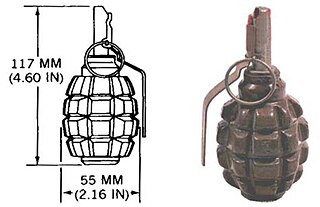
The Soviet F-1 hand grenade, is an anti-personnel fragmentation defensive grenade. It is based on the French F1 grenade and contains a 60 g (2.1 oz) explosive charge (TNT). The total weight of the grenade with the fuze is about 600 g (21 oz).
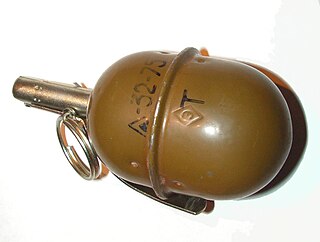
The RGD-5 is a post–World War II Soviet anti-personnel fragmentation grenade, designed in the early 1950s. The RGD-5 was accepted into service with the Soviet Army in 1954. It was widely exported, and is still in service with many armies in the Middle East and the former Soviet bloc.

RKG-3 is a series of Soviet anti-tank hand grenades. It superseded the RPG-43, RPG-40 and RPG-6 series of grenades. It entered service in 1950, and was still being used by insurgents in Iraq and Afghanistan into the 2000s and 2010s, against the vehicles of NATO forces.
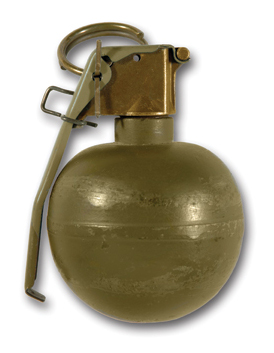
The M67 grenade is a fragmentation hand grenade used by the United States military. The M67 is a further development of the M33 grenade, itself a replacement for the M26-series grenades used during the Korean and Vietnam Wars, and the older Mk 2 "pineapple" grenade used since World War I.

The Mk 2 grenade is a fragmentation-type anti-personnel hand grenade introduced by the U.S. armed forces in 1918. It was the standard issue anti-personnel grenade used during World War II, and also saw limited service in later conflicts, including the Korean War and Vietnam War. Replacing the failed Mk 1 grenade of 1917, it was standardized in 1920 as the Mk II, and redesignated the Mk 2 on April 2, 1945.

The Soviet RGD-33 is an anti-personnel fragmentation stick grenade developed in 1933.

The M26 is a fragmentation hand grenade developed by the United States military. It entered service around 1952 and was used in combat during the Korean War. Its distinct lemon shape led it to being nicknamed the "lemon grenade".
The military of the United States has used many different types of hand grenades since its foundation.

The Model 39 "Eihandgranate", M39 or Eierhandgranate 39 was a German fragmentation hand grenade introduced in 1939 and produced until the end of World War II.
The Anti-Tank Mine, General Service, Mark IV was a British anti-tank mine used during World War II. Externally the mine has a cylindrical main body filled with explosive either TNT or Baratol. The mine is covered by a pressure plate, which is attached to the mine body by four pins which sit in vertical slots in clips that fold up from the bottom of the mine. The mine uses the Shear-pin based Contact Mine Fuze No.3 Mk I. The fuze consists simply of a spring-loaded striker pin restrained by a shear pin. Sufficient pressure on the pressure plate presses the plate down on the head of the fuze, breaking the shear wire and releasing the striker, which is driven into the detonator by the striker spring.

The HG 85 is a round fragmentation hand grenade designed for the Swiss Armed Forces, and is still produced by RUAG Ammotec in Switzerland. HG 85 is the internal designation of the Swiss Army and replaced the HG 43 from World War II.

A grenade is an explosive weapon typically thrown by hand, but can also refer to a shell shot from the muzzle of a rifle or a grenade launcher. A modern hand grenade generally consists of an explosive charge ("filler"), a detonator mechanism, an internal striker to trigger the detonator, an arming safety secured by a transport safety. The user removes the transport safety before throwing, and once the grenade leaves the hand the arming safety gets released, allowing the striker to trigger a primer that ignites a fuze, which burns down to the detonator and explodes the main charge.

Poudreries Réunies de Belgique SA was one of Belgium's oldest and largest manufacturers of munitions, once the second-largest Belgium armaments manufacturer. The company indirectly started in 1778 in Wetteren as a gunpowder factory. By its 200th anniversary in 1979 it had 73 factories throughout the world, with the headquarters in Brussels.

The M549 is a high-explosive rocket-assisted (HERA) 155 mm howitzer round developed for use by the US military in order to add additional range to standard howitzers, with a maximum range 30.1 km from a M198 howitzer. The projectile has two distinctive pre-assembled components—the high explosive (HE) warhead and the rocket motor, making it a form of rocket-assisted projectile. The warhead is fabricated from high fragmentation steel for increased effectiveness in terms of damage caused to target and contains a bulk-filled explosive.
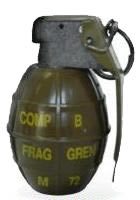
The Mecar M72 is a fragmentation hand grenade used by the Belgian military. It was designed by Belgian company PRB, with Mecar taking over production after PRB closed. Made by PRB it was known both as the PRB 423 and the M72.
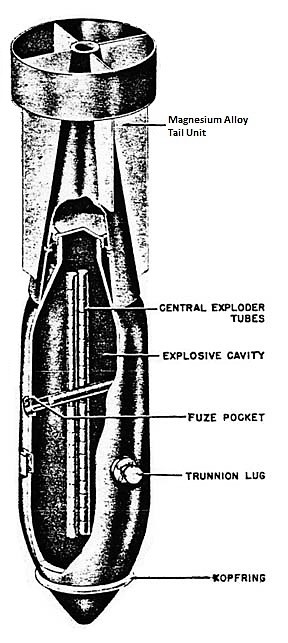
The SD 1700 or thick walled explosive bomb in English was a fragmentation bomb used by the Luftwaffe during World War II.
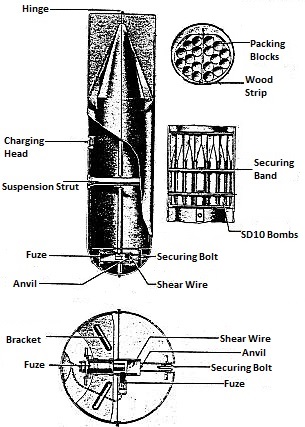
The AB 500-1(Abwurfbehälter) was a cluster bomb used by the Luftwaffe during World War II.

The Shaving Stick Grenade was an offensive grenade that was developed by Germany and used by the Wehrmacht during World War II.

















